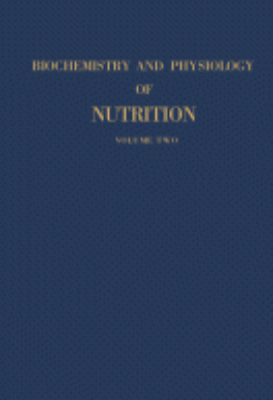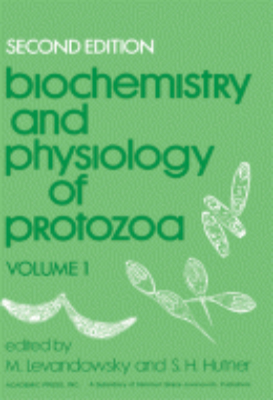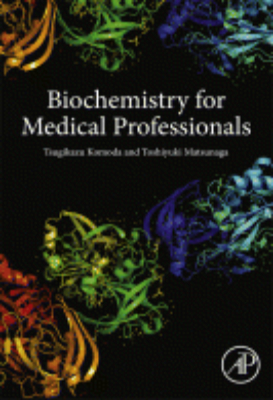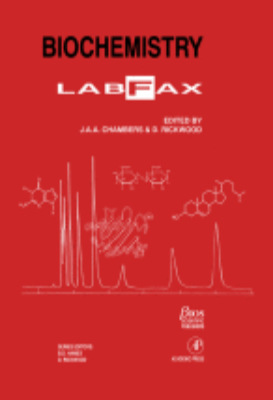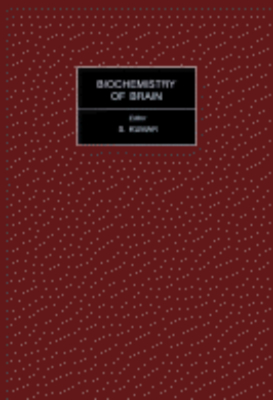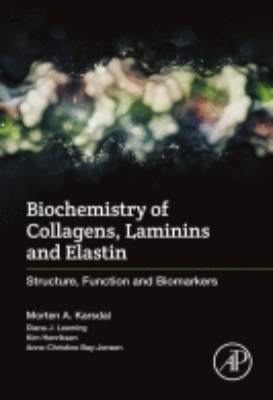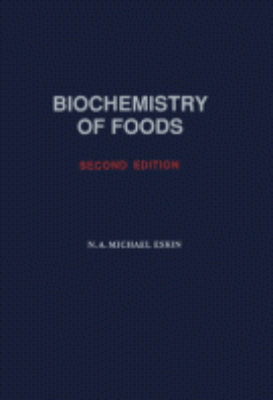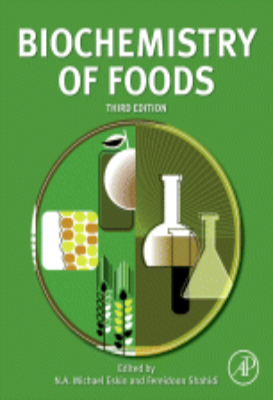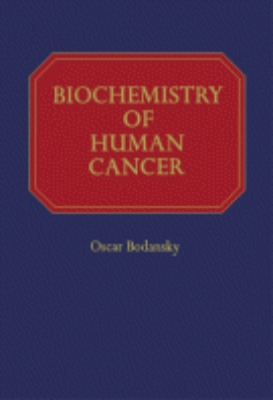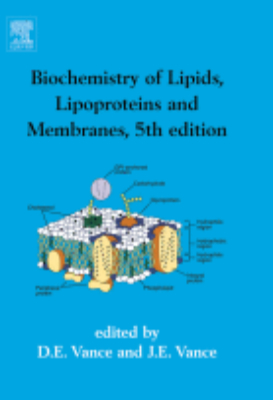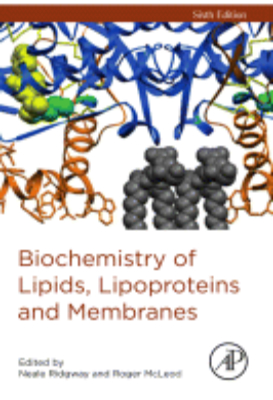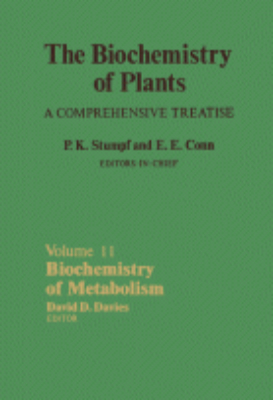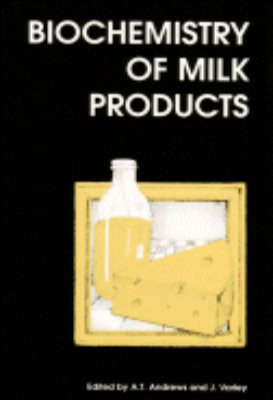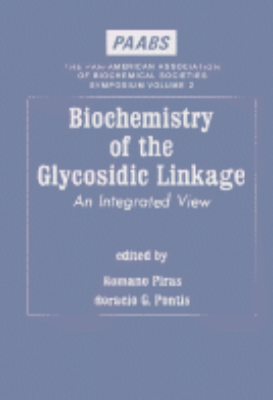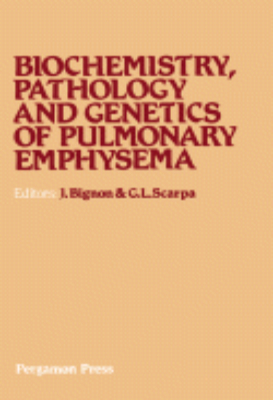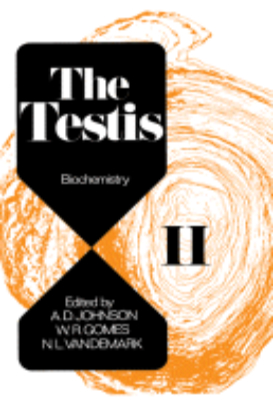E-Resources
Biochemistry and Physiology of Nutrition
Biochemistry and Physiology of Nutrition, Volume II focuses on the processes, methods, and studies on nutrition. The book starts by discussing intracellular localization through histochemical methods of enzymes and vitamins; the structural changes in vitamin deficiency; and microbiology of digestion. Deficiencies in vitamins, A, C, D, E, B1, riboflavin, nicotinic acid, choline, biotin, and folic acid are noted. The book then focuses on microbiology of digestion, considering the establishment of microbial population in the alimentary tract, results of microbial digestion, antibiotics, and intestinal flora of man. The text also defines the nutrition system of worms, insects, and protozoa. The generation of ATP in terminal respiration and anaerobic glycolysis, as well as ATP's role in energy transfer, is noted. The discussions also focus on hydrolytic and phosphorylitic enzymes, such as carbohydrates, esterases, amidases, phosphatases, and phosporylases. Other topics covered are respiratory enzymes and coenzymes in which nucleotides, glucose diphosphate, diphosphoglyceric acid, and thiamine pyrophosphate are noted. The book notes the functions of iron compounds in the body, particularly in blood and tissues, and then touches on calcium and phosphorus metabolism. Given considerations are calcium and phosphorus in blood, skeletal calcium and phosphorus, and the factors affecting adsorption. A discussion also focuses on trace elements and the effects of protein, carbohydrates, fats, and vitamins in nutrition. The book is a vital source of data for readers interested in studying the elements, factors, processes, and methods involved in nutrition.
Biochemistry and Physiology of Plant Immunity
Biochemistry and Physiology of Plant Immunity details the physiological properties of plant immunity from a biochemical perspective. The book provides a summary and concise explanation of the various studies conducted on the field of biochemistry and physiology of plant immunity. The text first details the evolution of parasitism, and then proceeds to discussing the biochemistry and physiology of heterotrophic micro-organisms. Next, the selection talks about the biochemistry and physiology of diseased plant, before it finally deals with plant immunity. The book will be of great use to researchers and practitioners of disciplines that deal with the health of vegetation, such as botany and horticulture.
Biochemistry and Physiology of Protozoa
Biochemistry and Physiology of Protozoa, Second Edition, Volume 1 is organized into 13 chapters, beginning with a discussion on fine structure and phytogeny of phytoflagellates. This book discusses the structural features of protozoan cytochromes. Subsequent chapters explain sterol and carotenoid distributions in various groups, phycobiliproteins in cryptomonads, halotolerance in Dunaliella, physiology of coccolithophorids, the ameboflagellates, and bioluminescence of phytoflagellates. This edition also describes the most severe and best known of the toxins, saxitoxin, produced by species of Gonyaulax. Lastly, the physiological ecology of red tide flagellates is explained.
Biochemistry for Medical Professionals
Biochemistry for Medical Professionals contains pivotal advances in the biochemistry field and provides a resource for professionals across medicine, dentistry, pharmaceutical sciences and health professions who need a concise, topical biochemistry reference. Relevant, well-illustrated coverage begins with the composition of the human body and then goes into the technical detail of the metabolism of the human body and biochemistry of internal organs before featuring a biotechnology study inclusive of numerous methods and applications. The work is written at a consistently high level, with technical notes added to aid comprehension for complex topics.
Biochemistry LabFax
LABFAX volumes are purpose-designed data reference books for practising scientists. Each book presents key information for a major subject in one place and so saves hours of searching. It does not simply collect together data which are already available in catalogues since these are often incomplete and can contain conflicting information. Rather, the authors and editors of each LABFAX volume have searched the original literature for the accurate data which they know the specialist needs.Biochemistry LabFax is a detailed compendium of essential information - on radioisotopes, enzymes, proteins, nucleic acids, lipids, plus data on selected techniques such as chromatography, electrophoresis, etc. - needed on an almost daily basis by researchers in any area of biochemistry. In addition, the book acts as a gateway to other sources for information more specific than can be covered in a volume of this size.
Biochemistry of Brain
Biochemistry of Brain is a collection of articles dealing with the developments in the biochemistry of the brain. This book gives a comprehensive and critical discussion of important developments in studies concerning the above subject. This text discusses the structure, function, and metabolism of glycosphingolipids, which are related to the study of sphingolipid storage diseases. Inborn defects of metabolism are found in Gaucher's and Fabry's disease, which are characterized by lipid accumulation in the brain. Another paper reviews the chemical and genetics of critically lysosomal hydrolase deficiencies that can cause the storage of sphingolipids. This book then explains the role of myelin basic protein in lipids in vivo that the weak bonding of the protein is not a major component of myelin stability. Another paper discusses the procedures for isolating subfractions of myelin and myelin-related membranes, with some attention given on the alterations in the subfractionation of myelin in pathological hypomyelinating and demyelinating conditions. Another article discusses the biochemical and enzymatic composition of lysosomes and the biosynthesis, intracellular transport, storage, and the degradation of lysosomal constituents. This collection of papers will benefit scientists doing research in microbiology, microchemistry, molecular genetics, and neurochemistry.
Biochemistry of Cancer
Biochemistry of Cancer focuses on cancer research, including induction, chemical composition, and growth of tumors and chemotherapy. The book first offers information on the general phenomena and taxonomy of cancer. Discussions focus on the transmissibility of tumors and experimental basis of cancer research; cancerous transformation of animal tissues in vitro; growth and the vascular reactions of tumors; and classification of animal tumors. The text also ponders on the extrinsic factors in the induction of tumors, including comparative carcinogenicity of hydrocarbons, metabolic fate of injected hydrocarbons, dosage and response to carcinogenic hydrocarbons, and polycyclic hydrocarbons. The manuscript takes a look at the intrinsic factors in the induction of tumors. Topics include influence of sex hormones on carcinogenesis of sex and accessory sex tissues; viruses as causative agents for fowl tumors and rabbit papillomas; and possibility of relatively non-specific endogenous carcinogens. The publication also elaborates on attempts to control tumor induction and growth and the chemistry of tumors. The book is a vital reference for readers interested in the biochemistry of cancer.
Biochemistry of Characterised Neurons
Biochemistry of Characterised Neurons provides a report on the progress made in the analysis of the biology of specific neurons in the central nervous system. This book emphasizes the biochemical, morphological, and functional aspects of characterized neurons, including ways and sophisticated techniques of isolating them. This publication is divided into 11 chapters. The first chapter evaluates the relevance of working with single neurons. Chapters 2 to 6 discuss specific, characterized, invertebrate neurons containing one of the putative neurotransmitter substances. Chapter 7 deals with the biochemistry of a unique vertebrate (Torpedo) cholinergic system that enables pure cholinergic neuronal cell bodies and endings to be analyzed separately. The sensitive radiochemical procedures used to analyze transmitter substances and transmitter enzymes, and how they can be adapted to map the distribution of transmitters in individual neurons of Aplysia, are discussed in Chapter 8. Chapter 9 describes methods for the analysis of specific cells in the retina, while Chapters 10 and 11 focus on the analysis of proteins within defined neurons. This text is beneficial to biochemists and students interested in analyzing neurons.
Biochemistry of Collagens Laminins and Elastin
"Biochemistry of Collagens, Laminins, and Elastin: Structure, Function, and Biomarkers provides a comprehensive introduction to collagen and structural proteins. Type I collagen is one of the most abundant molecules in the body, playing essential roles in different tissues, particularly bone and skin. A key aspect of type I collagen is its post-translational modifications which are essential for correct synthesis and structural integrity of collagens, for tissue-specific functionality, as well as for application as biomarkers of different pathologies. This volume summarizes current data on key structural proteins (collagens, laminins and elastin), reviews how these molecules affect pathologies, and describes selected modifications of proteins that result in altered signaling properties of the original extracellular matrix component. Further, it discusses the novel concept that an increasing number of components of the ECM harbor cryptic signaling functions that may be viewed as endocrine functions. Additionally, it highlights how this knowledge can be exploited to modulate fibrotic disease. Key Features. Provides a comprehensive introduction to collagen and structural proteins. Provides insight into emerging analytical technologies that can detect biomarkers of extracellular matrix degradation. Includes a chapter dedicated to the biomarkers of structural proteins. Contains insights into the biochemical interactions and changes to structural composition of proteins in disease states"
Biochemistry of Foods: 1971
Biochemistry of Foods attempts to emphasize the importance of biochemistry in the rapidly developing field of food science, and to provide a deeper understanding of those chemical changes occurring in foods. The development of acceptable fruits and vegetables on postharvest storage is dependent on critical biochemical transformations taking place within the plant organ. The chapters discuss how meat and fish similarly undergo postmortem chemical changes which affect their consumer acceptability. In addition to natural changes, those induced by processing or mechanical injury affect the quality of foods. Such changes can be controlled through an understanding of the chemical reactions involved, for instance, in enzymic and nonenzymic browning. Increased sophistication in food production has resulted in the widespread use of enzymes in food-processing operations. Some of the more important enzymes are discussed, with an emphasis on their role in the food industry. The final chapter is concerned with the biodeterioration of foods. The various microorganisms involved in the degradation of proteins, carbohydrates, oils, and fats are discussed, with special reference to the individual biochemical reactions responsible for food deterioration.
Biochemistry of Foods: Third Edition 2013
"This bestselling reference bridges the gap between the introductory and highly specialized books dealing with aspects of food biochemistry for undergraduate and graduate students, researchers, and professionals in the fi elds of food science, horticulture, animal science, dairy science and cereal chemistry. Now fully revised and updated, with contributing authors from around the world, the third edition of Biochemistry of Foods once again presents the most current science available. The first section addresses the biochemical changes involved in the development of raw foods such as cereals, legumes, fruits and vegetables, milk, and eggs. Section II reviews the processing of foods such as brewing, cheese and yogurt, oilseed processing as well as the role of non-enzymatic browning. Section III on spoilage includes a comprehensive review of enzymatic browning, lipid oxidation and milk off-flavors. The final section covers the new and rapidly expanding area of rDNA technologies. This book provides transitional coverage that moves the reader from concept to application. Key Features. Features new chapters on rDNA technologies, legumes, eggs, oilseed processing and fat modification, and lipid oxidation. Offers expanded and updated material throughout, including valuable illustrations. Edited and authored by award-winning scientists"
Biochemistry of Human Cancer
Biochemistry of Human Cancer focuses on advances in the application of biochemistry to the study of human cancers, such as neoplastic immunoglobulinopathies, cancer of the bladder, tumors of the neural crest, leukemias and lymphomas, and neoplasms of the bone. It also examines certain features of human cancer ranging from general metabolic characteristics to enzymic aspects and immunochemical considerations. Organized into 18 chapters, this book begins with an overview of the general metabolic features of cancer, with emphasis on the metabolism of lipids, proteins, and carbohydrates. It then discusses the important biochemical aspects of pulmonary and prostatic neoplasms, including the serum acid and alkaline phosphatase activities of prostatic carcinoma. The remaining chapters look at the role of enzymes and immunoglobulins in cancer, the tryptophan metabolism in cancer of the bladder and the carcinoid syndrome, the link between amino acid metabolism and tumors of the neural crest, and the neoplasms of the digestive tract and the accessory organs (pancreas and liver). The book explains the metabolism of purines and pyrimidines in cancer, hypercalcemia in neoplastic disease without evidence of bone metastases, and neoplasms of other organs, such as the pituitary gland, thyroid, testis, and adrenal cortex. Brief case reports from the literature are included to illustrate correlations between biochemical and clinical findings. Scientists, biochemists, and clinical investigators concerned with the biochemistry of human cancer will find this book highly informative.
Biochemistry of Insects
Biochemistry of Insects reviews the state of knowledge in insect biochemistry. The book begins by examining the function of carbohydrates in regulating and maintaining the life processes of insects. This is followed by separate chapters on the functional roles of lipids and proteins in insects; and protein synthesis in insects. Subsequent chapters cover the chemistry of insect cuticle; the structure, distribution, and chemistry of insect biochromes; and chemical control of insect behavior. Also discussed are the biochemical aspects of the natural products used by insects in defensive contexts; the reaction of insecticides and related compounds with their targets; detoxification mechanisms in insects; and genetic variation in natural populations. Designed to serve as a basic textbook in field, this volume should be equally useful as an auxiliary text for most relevant courses in insect biology, particularly insect physiology, insect ecology, insect control, and economic entomology. The book should also serve as an important reference source for the advanced student, the research scientist, and the professional entomologist seeking authoritative details of relevant areas of subject matter.
Biochemistry of Lipids
MTP International Review of Science: Biochemistry Series One, Volume 4: Biochemistry of Lipids focuses on the processes, methodologies, reactions, and approaches involved in the biochemistry of lipids. The selection first elaborates on the enzymes of sterol biosynthesis and lipids in glycan biosynthesis. Topics cover polyprenols and glycan biosynthesis in green plants; polyprenols and glycan biosynthesis in yeasts and fungi; undecaprenol and bacterial wall glycan biosynthesis; methods of investigating particle-bound enzymes of sterol biosynthesis; and relationship of the multi-enzymic synthesis of cholesterol to other microsomal processes. The text then elaborates on the biosynthesis of saturated fatty acids, dynamic role of lipids in the nervous system, and biosynthesis of unsaturated fatty acids. Discussions focus on anaerobic pathway of monoenoic fatty acid biosynthesis, exchange of brain lipids, lipids and transmission in the nervous system, fatty acid synthetase, and lipid distribution within the nervous system. The manuscript examines halogenated sulphatides and prostaglandins, including identification of prostaglandins in organs and body fluids, estimation of prostaglandins, and occurrence of halosulphatides in membranes. The selection is a valuable reference for researchers interested in the biochemistry of lipids.
Biochemistry of Lipids, Lipoproteins and Membranes: Fifth Edition 2008
"Research on the biochemistry and molecular biology of lipids and lipoproteins has experienced remarkable growth in the past 20 years, particularly with the realization that many different classes of lipids play fundamental roles in diseases such as heart disease, obesity, diabetes, cancer and neurodegenerative disorders. The 5th edition of this book has been written with two major objectives. The first objective is to provide students and teachers with an advanced up-to-date textbook covering the major areas of current interest in the lipid field. The chapters are written for students and researchers familiar with the general concepts of lipid metabolism but who wish to expand their knowledge in this area. The second objective is to provide a text for scientists who are about to enter the field of lipids, lipoproteins and membranes and who wish to learn more about this area of research. All of the chapters have been extensively updated since the 4th edition appeared in 2002. Key Features. Represents a bridge between the superficial coverage of the lipid field found in basic biochemistry text books and the highly specialized material contained in scientific review articles and monographs. Allows scientists to become familiar with recent developments related to their own research interests, and will help clinical researchers and medical students keep abreast of developments in basic science that are important for subsequent clinical advances. Serves as a general reference book for scientists studying lipids, lipoproteins and membranes and as an advanced and up-to-date textbook for teachers and students who are familiar with the basic concepts of lipid biochemistry"
Biochemistry of Lipids, Lipoproteins and Membranes: Sixth Edition 2015
"Biochemistry of Lipids: Lipoproteins and Membranes, Volume Six, contains concise chapters that cover a wide spectrum of topics in the field of lipid biochemistry and cell biology. It provides an important bridge between broad-based biochemistry textbooks and more technical research publications, offering cohesive, foundational information. It is a valuable tool for advanced graduate students and researchers who are interested in exploring lipid biology in more detail, and includes overviews of lipid biology in both prokaryotes and eukaryotes, while also providing fundamental background on the subsequent descriptions of fatty acid synthesis, desaturation and elongation, and the pathways that lead the synthesis of complex phospholipids, sphingolipids, and their structural variants. Also covered are sections on how bioactive lipids are involved in cell signaling with an emphasis on disease implications and pathological consequences. Key Features. Serves as a general reference book for scientists studying lipids, lipoproteins and membranes and as an advanced and up-to-date textbook for teachers and students who are familiar with the basic concepts of lipid biochemistry. References from current literature will be included in each chapter to facilitate more in-depth study. Key concepts are supported by figures and models to improve reader understanding. Chapters provide historical perspective and current analysis of each topic"
Biochemistry of Metabolism
The Biochemistry of Plants: A Comprehensive Treatise, Volume 11: Biochemistry of Metabolism provides information pertinent to the chemical and biochemical aspects of metabolism. This book discusses the control mechanisms of metabolism. Organized into nine chapters, this volume begins with an overview of the history of biochemistry and discusses the developments in the kinetics of regulatory enzymes. This text then examines a theory that explains how subunit interactions modulate the rate of conversion of a substrate into a product. Other chapters consider some relation between cell-wall elongation and cell-wall charge density and explore the subcellular localization of the enzymes of glycolysis. This book discusses as well the regulation of glycolysis and the pentose phosphate pathway. The final chapter deals with the pathways of C1 metabolism that are of prime importance, as the synthesis of several cellular constituents depends directly or indirectly on folate metabolism. This book is a valuable resource for plant biochemists, neurobiochemists, molecular biologists, senior graduate students, and research workers.
Biochemistry of Milk Products
Biochemistry of milk products documents advances in the field and focuses on the two most active areas of research areas, which are starter cultures and enzymes for use in cheese and other foods, and factors influencing the functional properties of milk.The book covers the current thinking and research on the roles of proteinases and peptidases in the milk clotting process and in texture and flavour development during maturation of product. It also covers the protein engineering of enzymes and molecular biological manipulation of microorganisms, including the use of protein engineering to clarify the molecular basis of functional behavior and to manipulate protein properties in a defined and planned way.Biochemistry of milk products provides important reading for research workers, lecturers, graduates and final year undergraduates with interest in the practical applications of molecular biology, enzymology, and protein chemistry, not just in improving the quality and performance of dairy foods and ingredients but also in a much wider context.
Biochemistry of Parasites
Biochemistry of Parasites, Second Edition presents the biochemical aspects of parasitology. The topics covered in the book include inorganic substances; carbohydrate relationships of parasites; parasitic metabolism of carbohydrates and transport mechanisms; distribution of lipids in the bodies of parasites; and disturbances in the host's protein metabolism during parasitic infections. Parasitologists and biochemists will find the book interesting.
Biochemistry of Platelets
Biochemistry of Platelets is a comprehensive review of the biochemistry of platelets, with emphasis on the molecular basis for the various biological processes in which they participate. Topics range from stimulus-response coupling mechanisms to platelet contractile proteins, platelet membrane glycoproteins, and storage organelles in platelets and megakaryocytes. The expression and function of adhesive proteins on the platelet surface is also discussed. Comprised of 12 chapters, this book begins with a description of the morphological and metabolic responses to agonists, as well as the involvement of certain processes in the coupling of agonist-receptor interactions to platelet responses. The following chapter deals with platelet arachidonate metabolism and platelet-activating factor, focusing on the release of arachidonate from platelet lipid stores; pathways of platelet arachidonate metabolism and effects of arachidonate metabolites; and inhibition of platelet arachidonate metabolism by aspirin. The structure, function, and modification in disease of platelet membrane glycoproteins are then discussed, along with prothrombin activation on platelets and platelet regulation of thrombus formation. Secreted platelet proteins as markers for pathological disorders are also considered. This monograph is intended as a reference for investigators involved in platelet research as well as a source of information for those working in other areas of biological investigation.
Biochemistry of Smooth Muscle Contraction
This valuable resource provides a systematic account of the biochemistry of smooth muscle contraction. As a comprehensive guide to this rapidly growing area of research, it covers the structure and characteristic properties of contractile and regulatory proteins, with special emphasis on their predicted function in the live muscle. Also included in this book are intermediate filament proteins, and desmin and vimentin, whose function in smooth muscle is unknown; and several enzymes involved in the phosphorylation-dephosphorylation of contractile and other proteins.
Biochemistry of Taste and Olfaction
Biochemistry of Taste and Olfaction examines the biochemical aspects of taste and olfaction and their relevance to nutrition, medicine, and food science. More specifically, it considers the biological processes that influence dietary habits, nutritional status, and enjoyment of food, as well as other important social and biological phenomena. It also describes biochemical mechanisms at the peripheral receptor level in taste and olfaction, with emphasis on the role of the cell surface, along with neurotransmitters and other neurochemical aspects of the olfactory system. Organized into five sections comprised of 24 chapters, this book begins with an overview of biochemical approaches used in studying the phenomena of taste and olfaction. It then proceeds with a discussion of olfactory receptor mechanisms, the accessibility of odorant molecules to the receptors, the role of cilia in olfactory recognition, and the involvement of receptor proteins in vertebrate olfaction. Middle chapters focus on the chemosensation, major histocompatibility complex and olfactory receptors, taste receptor mechanisms, biochemistry of sugar reception in insects, intensity/time phenomena in sugar sweetness, and recognition of taste stimuli at the initial binding interaction. The reader is also introduced to the physicochemical principles of taste and olfaction, molecular mechanisms of transduction in chemoreception, biochemical mechanisms in vertebrate primary olfactory neurons, neurotransmitter biochemistry of the mammalian olfactory bulb, and chemical sensing by bacteria. Examples of chemical sensory systems are included. This book will be of interest to biochemists, physiologists, neurobiologists, neuroscientists, molecular biologists, food scientists, students, and specialists in psychology, neurophysiology, organic chemistry, and nutrition.
Biochemistry of the Amino Acids
Biochemistry of the Amino Acids, Second Edition, Volume II focuses on the trends in research on amino acids and biochemistry. Given considerations are incorporation of amino acids into proteins, amino acid sequences, and discovery of amino acids. The first part of the book deals with intermediary metabolism of amino acids. Particularly noted are alanine, aspartic, adenylosuccinic, hydroxyaspartic acids, and asparagine. The book also has discussions on glutamic acid, glutamine, glycine, serine, and sarcosine. The processes and syntheses involved in these acids are noted. Another part of the book focuses on the formation, degradation, reactions, and conversion of acids. The processes and experiments discussed are supported by numerical analysis, and the biosynthesis of acids in microorganisms is also considered. The book also notes some disorders of amino acid metabolism in humans. These disorders include cystinuria, glycinuria, ammonemia, prolinemia, maple syrup urine disease, and homocystinuria. Discussions focus on how these diseases develop and the symptoms associated with them. The book is a vital source of data for readers interested in the study of amino acids.
Biochemistry of the Eye
"A readable introduction to this difficult topic, this textbook provides information on the molecular structures and biochemical events that occur in the eye. With specific clinical examples, basic science is linked to clinical practice and helps students understand this challenging topic.General biochemistry is discussed in each chapter. Many examples of biochemical pathology and disease processes, such as age-related cataract formation and ocular diabetes, are described. Key Features. Well-illustrated content, featuring color inserts with 10 illustrations, shows visual aspects of biochemistry.. Each chapter features a general review of the subject matter prior to discussing ocular biochemistry.. Discussions of proteins that are either unique to the eye and/or have special functions in the eye, such as collagen's role in the structure of the cornea, emphasize the importance of these compounds and their many essential cellular and ocular functions.. Discussions of the nature and function of enzymes, in addition to descriptions of examples of specific enzymes found in the eye, highlight the manner in which many biochemical reactions occur in the eye is via enzyme catalysis.. A chapter on carbohydrates emphasizes the importance of the two roles of carbohydrates in ocular tissue: energy supply (nutrition) and as a source of extracellular structure.. An explanation of the many different kinds of lipids that exist in the eye features the most up-to-date material on tear film lipids and useful information on dietary Vitamin A requirements.. A chapter on hormones deals with the role of hormones in general and shows how hormones play roles in ocular functions, including the process of visual transduction as a hormonal function.. A thorough review of nucleic acid chemistry points out its role in molecular biological functions such as DNA replication, RNA transcription, and protein translation, as well as DNA mutations.. A chapter on neurochemistry provides an understanding of basic neurochemistry and how neurochemistry can explain the complex functions of the retina.. The immunochemistry chapter contains basic material on biochemical and cellular immunology, discussing immune privilege in the eye and the importance of immune reactions at the anterior segment.. A new chapter describes the biochemical pathology of four degenerative conditions (corneal ulcers, chemical burns, glaucoma, and cellular apoptosis) to help the clinician understand pathological processes and the time course of degenerative processes and methods of treatment.. A new chapter on Water and Ocular Fluids offers unique coverage of the functions of eye fluids and how drug companies must design drugs for the ocular surface, comparing the physical, chemical, and biological properties of water with fluids found in the eye."
Biochemistry of the Glycosidic Linkage: An Integrated View
Biochemistry of the Glycosidic Linkage: An Integrated View is a collection of papers presented at The Pan-American Association of Biochemical Societies Symposium, held in San Carlos de Bariloche, Argentina on November 8-11, 1971. This symposium is organized as a tribute to Luis F. Leloir and his contributions in the field glycosidic linkage. This book is divided into six sessions encompassing 57 chapters. The opening session discusses the role of biochemical mechanisms in the glycosidic linkage formation. The following sessions examine the metabolic functions of some disaccharides, such as trehalose, sucrose, glucose, and starch. These sessions also look into the biosynthesis, function, and properties of carbohydrates containing polymers. The discussion then shifts to the control of enzyme biosynthesis involved in the glycosidic linkage metabolism, with particular emphasis on alpha-amylase, lactose synthetase, phosphorylase, and neuraminidase enzymes. Another session is devoted to the regulatory mechanisms and control of glycogen metabolism. The concluding session covers the genetic analysis and biochemical characterization of the enzymes involved in the glycosidic linkage metabolism. Biochemists and carbohydrate researchers will find this text invaluable.
Biochemistry of Thermophily
Biochemistry of Thermophily covers the proceedings of a seminar held under the auspices of the U.S.-Japan Cooperative Science Program at the East-West Center in Honolulu, Hawaii on June 22-24, 1977. This seminar focuses on biochemistry of thermophilic microorganisms. It presents an achievement in the complex field of thermophiles and their unique properties. This book discusses the fatty acid composition in several strains of moderately and extremely thermophilic bacteria, the membrane and lipid components, the biosynthesis and function of -cyclohexyl fatty acids, and the influence of growth temperature and lipid state on lipid and protein distribution. It then presents the ecologic and genetic aspects of thermophilic bacteria, including their morphology, surface structure, and transfection. It also examines the function and thermostability of ribosomal proteins, polypeptides, and polyamines in thermophilic bacteria. Finally, the book discusses the thermostability of proteins, the effect of amino acid substitution on conformational stability of thermophile, the thermophilic enzymes, and the physiology of thermophilic bacteria. This book will be helpful to molecular and research biologists, teachers, and students who wish to expand their understanding on mechanisms of thermophilicity, thermostability, and thermophilic microorganisms.
Biochemistry of Vision
Biochemistry of Vision provides information pertinent to vision biochemistry. This book discusses the biochemical information derived primarily from studies on nonocular tissues and describes the biochemical reactions related to the function of the retina and pigmented epithelium. Organized into 16 chapters, this book begins with an overview of the visual system and the structure of the vertebrate eye. The text then proceeds with a discussion of photoreceptor, which has a highly membranous structure. Other chapters cover a brief discussion of several topics, including biomembranes, photochemistry, spectral properties of retinal isomers, and the photochemical properties of the chromophore of rhodopsin. This book discusses as well the properties and intramembrane disposition of rhodopsin. The final chapter deals with the biochemistry of photoreceptor disorders and summarizes the basic knowledge on neurotransmitters and electrophysiology in the retina. This book is intended for ophthalmologists and medical students who are interested in the molecular aspects of photoreceptor diseases.
Biochemistry Pathology and Genetics of Pulmonary Emphysema
Biochemistry, Pathology and Genetics of Pulmonary Emphysema documents the proceedings of an international symposium held in Sassari, Italy, 27-30 April 1980. Research on the origins of emphysema has acquired more importance than functional diagnostic studies. There are various hypotheses concerning the development of emphysema. Some cases of emphysema are linked to defects in metabolic functions of the vessels while others are linked to a disturbance in repair processes. The papers in this volume are organized into four sections. Section 1 contains studies on the pathology and biochemistry of lung connective tissue. Section 2 deals with animal models. Section 3 on proteases and antiproteases includes studies on the characteristics and identification of biological specimens, and alpha1-proteinase inhibitor. Section 4 takes up the risk factors and therapeutic approaches for lung disease. Other papers in the volume were presented during two roundtable discussions on the biochemistry of connective tissue components in emphysema and therapeutic approaches.
Biochemistry: 1970
The Testis, Volume II: Biochemistry focuses on the study of the biochemistry of mammalian testis. Composed of contributions of authors, the book starts with the endocrinology of the testis. Topics covered include testicular estrogens and androgens; the effect of age on testicular steroidogenesis; and endocrine regulation of spermatogenesis. The compilation also presents a histochemical analysis of the localization of testicular enzymes. Covered are histochemistry; enzymes of the fetal and mature testis; and the factors affecting testicular enzymes. The text notes as well that blood flow, hormones, nutrition, age, and temperature can affect testicular lipids and that the testis has testicular proteins and nucleic acids. The selection also outlines the growth and development of mammalian testis, and then ends with the discussions on hormonal regulation; chemical constituents; and testicular development, structure, and spermatogenesis of invertebrate testes. The compilation will best serve the interest of readers interested in studying the structure and functions of the testis.

